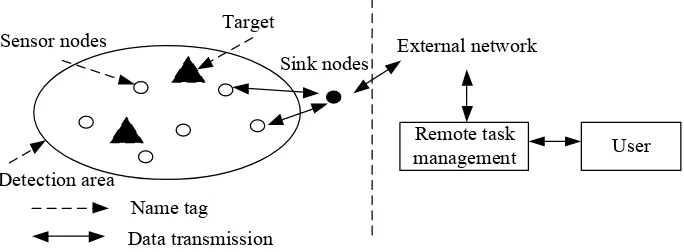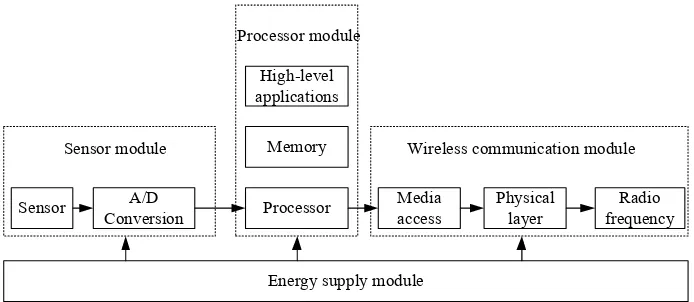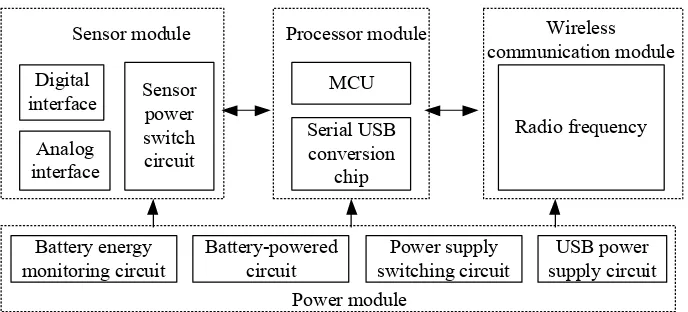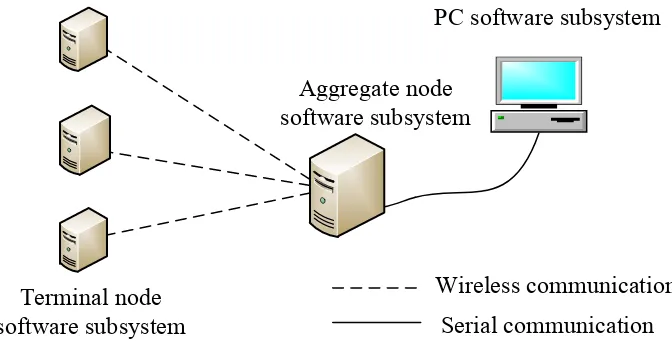Design and Implementation of a
Wireless Sensor Network Node Based on Arduino
https://doi.org/10.3991/ijoe.v13i11.7749Yang Wang
Jilin Engineering Vocational College, Jilin, China wang0390@sina.com
Abstract—For dealing with the limitations and deficiencies of present wire-less sensor network nodes, including poor flexibility, low degree of variability, low generality, Arduino development advantages are combined with ZigBee wireless communication technologies characteristics. The versatility and flexi-bility of wireless sensor network nodes and the cost and energy consumption of nodes are studied. First of all, ZigBee communication protocol and networking technology are studied, and based on this, communication protocols that the subjects need are designed. Secondly, the hardware system of ZigBee wireless sensor network node based on Arduino technology is discussed and designed. In addition, suitable Arduino development panel is selected in accordance with requirements of ZigBee wireless sensor network node. With the development panel as the design prototype, the circuit of functional module is designed. Thirdly, based on the wireless sensor network node communication protocol and hardware design, the software system of wireless sensor network node is designed and realized. The results showed that, through designing reasonable software working flow and compiling efficient information acquisition and wireless communication program, the intelligence orientation of node infor-mation acquisition and inforinfor-mation transmission is achieved. In a word, it can be concluded that, combined with Arduino, a better function can be achieved.
Keywords—Arduino, wireless sensor, network node
1
Introduction
not need to establish infrastructure in advance. Generally, a large number of wireless sensor network nodes are randomly placed in the monitored area, thus forming a net-work.
Arduino is a controller that has gained popularity rapidly in recent years. It is an open source electronic prototype platform with high flexibility, easy to use and low price. It has a rich interface, simple programming environment and great development freedom. The scalability of Arduino is very high, and it can rapidly design and im-plement personalized systems according to the field application requirements, and reduce the cost and volume of the system while improving system efficiency and versatility. This paper combines the ZigBee technology and wireless sensor technolo-gy in Arduino technolotechnolo-gy advantages, and conducts the research on wireless sensor network node that meets the needs of wireless sensor network applications. It is of important significance to broaden the space available for the wireless sensor network node.
2
Overview of related theories
2.1 Wireless sensor networks
Wireless sensor network can be defined as: the network system with multi hop and self-organized nature composed of information wireless transmission means and the wireless sensor network contains a large number of inexpensive sensor nodes with volume miniaturization. The main purpose of wireless sensor network is to collect and process the information which needs to be monitored in the monitored area, and to process the collected monitoring result and transmit it to the user. From the definition and purpose of the wireless sensor network, it can be seen that, sensor, monitoring target and user are the basic elements of the wireless sensor network. Wireless net-work is the key path linking the several basic elements, sensors, monitoring target, and users form a sensor network through a wireless communication mode, sensing and monitoring information in a collaborative manner. The characteristics of wireless sensor network include: limited power supply capacity, limited computing and storage capacity, limited information transmission capacity, large number of nodes, wide distribution and so on [2].
Fig. 1. Structure of wireless sensor network system
net. Then, these data information, through the external network, are transmitted to the remote task management nodes, so as to make a preliminary processing of the re-ceived data on the remote task management node. Finally, remote task management node will present the result data to the user after initial processing according to their own needs. The working process of the wireless sensor network to control the direc-tion is: users directly interfaced with the remote task management nodes, to send wireless sensor network control information to the remote task management node, and then, by the remote task manager node, it sends control information to the external network. Next, the control information is sent to the sink node by the external net-work and transmitted to the sensor node from the sink node [3].
Wireless sensor network nodes have different functions depending on the applica-tion scenarios. In the same applicaapplica-tion scenario, wireless sensor network nodes will also have functional differences depending on the specific work roles. However, the wireless sensor network nodes in different application scenarios and the wireless sensor network nodes with different working roles in the same application scene have the same basic structure. The basic structure consists of four parts: energy supply module, sensor module, processor module and wireless communication module. Among them, the processor module can be divided into processor, memory device and high application three parts; the sensor module can be divided into two parts: sensor and A/D converter; wireless communication module can be divided into physi-cal layer, medium access and RF (radio frequency ) three parts. The architecture of the wireless sensor network node is shown in Figure 2 [4].
2.2 Arduino technology
Arduino was originated from instructional development and then used for commer-cial development. It is a simple convenient and flexible software and hardware open-source electronics prototyping platform, derived from a simple I/O interface of open source code, and its development environment uses the programming language simi-lar to Java and C language. Arduino mainly consists of two parts: one is the hardware resources required by the development, including various types of Arduino circuit boards; the second is the software resources needed for the development, including
Data transmission Name tag
Remote task
management User
External network Target
Sink nodes Sensor nodes
Fig. 2. Structure of wireless sensor network node system
the unique development tools Arduino IDE programming environment and Arduino programming language. In the use of Arduino as a development tool, first of all, it is necessary to select a suitable Arduino circuit board for the development board accord-ing to the development needs, and then to write the function code in the Arduino IDE development environment. After the function code was written and compiled success-fully, the function code is download to the chosen Arduino development board, and in this way can the functions required by Arduino be achieved [5].
Arduino technology has gradually gained market acceptance and has been develop-ing rapidly in recent years, all of which benefit from its different features from other similar development technologies:
1.Arduino has various types of open circuit board design resources, and open pro-gram interface and propro-gram. All developers can download to view existing open source resources, and they can also upload the new research results in the field to the network resource sharing. Developers, in the development process, according to the official Arduino circuit board circuit diagram and PCB diagram, carry out the hardware circuit simplified design, to develop with the functional circuit oper-ating independently and that meets the needs.
2.Arduino board uses AVR series microprocessor with low price as the core control-ler, and designs USB power supply interface, external DC interface and other pow-er supply intpow-erfaces, which can not only reduce the development cost, but also en-hance the use flexibility of development board in different environments.
3. Arduino circuit board designs the support board ICSP burning program function and ICSP interface on the circuit board. Through the interface, the needed boot-loader firmware is directly burned into the controller AVR chip without external recording device. After the controller AVR chip gets the bootloader, the developer can update the firmware directly through the serial port or USB-RS232 line. 4.Arduino development environment Arduino IDE can support a variety of operating
systems, and for Windows, Linux and Mac systems, there are the corresponding executable versions.
Sensor ConversionA/D Processor
Memory High-level applications
Media
access Physical layer frequencyRadio
Energy supply module Processor module
5.Arduino programming language is similar to C language that this language con-tains a number of built-in functions. And these built-in functions can achieve a simple function through the not complicated statement, such as some common sen-sor communication, data conversion, serial reading and so on.
3
Method
As the basic unit of wireless sensor network, wireless sensor node design is the premise and basis of constructing the wireless sensor network, and the hardware de-sign of wireless sensor network node is the foundation of the whole node dede-sign. Therefore, on the basis of Arduino open source hardware, with the consideration of the low power consumption, scalability and ease of use, the hardware design of wire-less sensor network nodes is carried out.
In combination with the actual requirements of the project, the wireless sensor network node which is designed in this paper includes the sensor nodes as the termi-nal nodes and the non termitermi-nal nodes as routing nodes and sink nodes. The termitermi-nal node is mainly responsible for monitoring processing and transmitting the sensing data, and the non terminal nodes are responsible for transmitting the sensing data to the host computer in a variety of transmission modes. Although the two have different working modes and functional requirements, they are basically the same in the for-mation of the circuit hardware. As a result, this paper will take the generality as the principle to only perform the hardware design of sensor nodes in wireless sensor net-work, and the node can not only be used as a terminal node, but also as a non terminal node [6].
According to the general basic structure of wireless sensor network node, it is known that, the hardware system of wireless sensor network node must include pro-cessor module, sensor module, wireless communication module and power module. Among them, the power module serves as the power supply function component to provide energy for the entire sensor node, and the remaining three functional modules of the sensor nodes are energy consuming modules. In addition, the debugger and the download program interface should be considered to be added in the hardware design. Considering the low power consumption, small size, low cost and high flexibility design requirements of the node, the overall framework design of the hardware sys-tem of sensor nodes is shown in figure 3.
Analog interface
Sensor power switch circuit
Serial USB conversion
chip MCU
Battery energy
monitoring circuit Battery-powered circuit switching circuitPower supply
Radio frequency
USB power supply circuit Processor module
Sensor module Wireless
communication module Digital
interface
Power module
Fig. 3. The overall framework of hardware framework of sensor node
a USB power supply circuit, a power supply mode switching circuit and a battery energy monitoring circuit [7]. The design of the battery energy monitoring circuit aims to realize the intelligent management of the power supply of the node. It is worth noting that the design process of sensor node is divided into two parts. One part is the function module circuit design with reference to Arduino Uno R3 circuit design, and the other part is the circuit module design that Arduino Uno R3 cannot meet the sen-sor nodes and other functions. After the completion of the circuit design, the sensen-sor node PCB design and PCB board physical production are carried out.
4
Result and discussion
Serial communication
Wireless communication
PC software subsystem
Aggregate node
software subsystem
Terminal node
software subsystem
Fig. 4. The software system of wireless sensor network node
The working process of the software system of wireless sensor network node is: the equipment after powering on, the terminal node and sink node are networked, and then the sensor data and the power battery remaining electricity data are collected and processed by the terminal node. Next, in accordance with the ZigBee protocol, they are transmitted to the sink node in a wireless way, the sink node, after receiving the data sent by the terminal nodes, through USB connection line, is sent to the PC port, and the host computer on the PC machine reads the information obtained from the port and stores according to the classification [9]. And after the processing of all kinds of information, they are displayed on the interface of the host computer on the side of the PC machine.
5
Conclusion
6
References
[1] Klemenjak, C., Egarter, D., & Elmenreich, W. (2016). Yomo: the arduino-based smart me-tering board. Computer Science - Research and Development, 31(1-2), 97-103. http://dx.doi.org/10.1007/s00450-014-0290-8.
[2] Barbon, G., Margolis, M., Palumbo, F., Raimondi, F., & Weldin, N. (2016). Taking ar-duino to the internet of things: the asip programming model. Computer Communications, s 89–90, 128-140. http://dx.doi.org/10.1016/j.comcom.2016.03.016.
[3] Perez, M. S., & Carrera, E. (2015). Time synchronization in arduino-based wireless sensor networks. IEEE Latin America Transactions, 13(2), 455-461. http://dx.doi.org/10.1109/ TLA.2015.7055564.
[4] Harikrishnan, R. (2015). An integrated xbee arduino and differential evolution approach for localization in wireless sensor networks. Procedia Computer Science, 48, 447-453. http://dx.doi.org/10.1016/j.procs.2015.04.118.
[5] Lockridge, G., Dzwonkowski, B., Nelson, R., & Powers, S. (2016). Development of a low-cost arduino-based sonde for coastal applications. Sensors, 16(4). http://dx.doi.org/10.3390/s16040528.
[6] Sasirekha, S., & Swamynathan, S. (2017). Fuzzy rule based environment monitoring sys-tem for weather controlled laboratories using arduino. International Journal of Intelligent Information Technologies, 13(1), 50-66. http://dx.doi.org/10.4018/IJIIT.2017010103. [7] Sivakumar, M., Sadagopan, C., & Baskaran, M. (2016). Wireless Sensor Network to Cyber
Physical Systems: Addressing Mobility Challenges for Energy Efficient Data Aggregation Using Dynamic Nodes. Sensor Letters, 14(8), 852-857. https://doi.org/10.1166/sl.2016.36 24.
[8] Bo, J., Wang, Y., & Xu, N. (2016). Study of Wireless Sensor Network Route Based on Improved Ant Colony Algorithm. International Journal of Online Engineering, 12(10). https://doi.org/10.3991/ijoe.v12i10.6196.
[9] Tian, J., Gao, M., & Ge, G. (2016). Wireless sensor network node optimal coverage based on improved genetic algorithm and binary ant colony algorithm. EURASIP Journal on Wireless Communications and Networking, 2016(1), 104. https://doi.org/10.1186/s13638-016-0605-5.
7
Author
Yang Wang is with Jilin Engineering Vocational College, Jilin, China.



